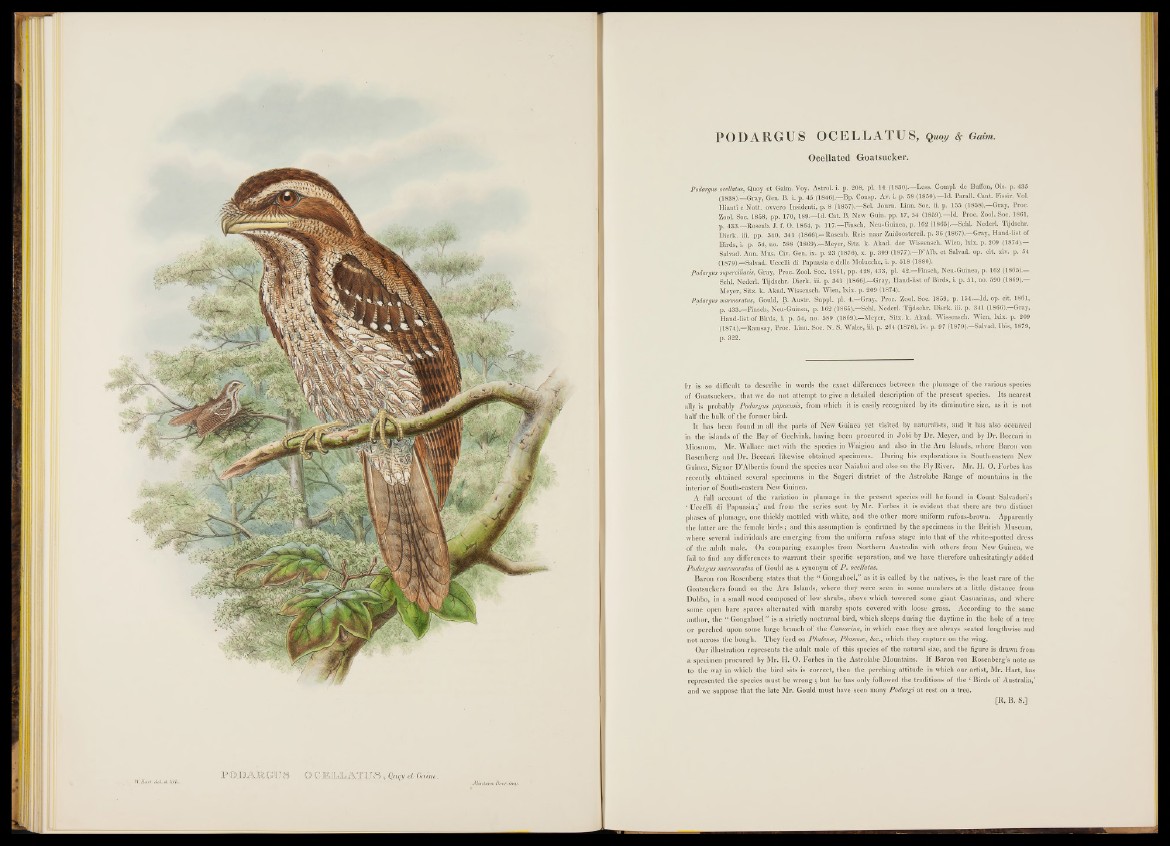
POJOAÄGIJS O G E L I iA W. Hai-t cUL.eb Hths. lD S , Qua^y eb Gaina.
POD ARGUS OCELLATUS, Quoy # Gam.
Ocellated Goatsucker.
Podargus occllalus, Quoy et Gaim. Voy. Astrol. i. p. 208, pl.. 14 (1830).—Less. CompL de Buffon, Ois. p. 435
(1838).—Gray, Gen, B. i. p. 45 (1846).—Bp. Consp. At. i. p. 58 (I860).—Id. Parali. Cant. Pissir. Vol.
Hianti e Nott. ovvero Insidenti, p. 8 (1857).—Sci. Journ. Linn. Soc. ii. p. 155 (1858).—Gray, Proc.
Zool. Soc. 1858, pp. 170, 189.—Id. Cat. B. New Guin. pp. 17, 54 (1859).—Id. Proc. Zool. Soc. 1861,
p. 433— Rosenb. J. f. O. 1864, p. 117.—Finsch, Neu-Guinea, p. 162 (1865).—Schl. Nederl. Tijdschr.
Dierk. iii. pp. 340, 341 (1866).— Rosenb. Reis naar Zuidoostereil. p. 36 (1867).—Gray, Hand-list of
Birds, i. p. 54, no. 588 (1869).—Meyer, Sitz. k. Akad. der Wissensch. Wien, lxix. p. 209 (1874).—
Salvad. Ann. Mus. Civ. Gen. ix. p. 23 (1876), x. p. 309 (1877).—D’Alb. et Salvad, op. cit. xiv. p. 54
(1879).—Salvad. Uccelli di Papuasia e delle Molucche, i. p. 518 (1880).
Podargus superciliaris, Gray, Proc. Zool. Soc. 1861, pp. 428, 433, pi. 42.—Finsch, Neu-Guinea, p. 162 (1865).—
Schl. Nederl. Tijdschr. Dierk. iii. p. 341 (1866).—Gray, Hand-list of Birds, i. p. 51, no. 590 (1869).—
Meyer, Sitz. k. Akad. Wissensch. Wien, lxix. p. 209 (1874).
Podargus marmoratus, Gould, B. Austr. Suppl. pi. 4.—Gray, Proc. Zool. Soc. 1859, p. 154.—Id. op. cit. 1861,
p. 433.—Finsch, Neu-Guinea, p. 162 (1865).—Schl. Nederl. Tijdschr. Dierk. iii. p. 341 (1866).—Gray,
Hand-list of Birds, i. p. 54, no. 589 (1869).—Meyer, Sitz. k. Akad. Wissensch. Wien, lxix. p. 209
(1874).—Ramsay, Proc. Linn. Soc. N. S. Wales, iii. p. 264 (1878), iv. p. 97 (1879).—Salvad. Ibis, 1879,
p. 322.
I t is so difficult to describe in words the exact differences between the plumage o f the various species
of Goatsuckers, th at we do not attempt to give a detailed description o f the present species. Its nearest
ally is probably Podargus papuensis, from which it is easily recognized by its diminutive size, as it is not
half the bulk o f the former bird.
I t has been found in all the parts o f New Guinea yet visited by naturalists, and it has also occurred
in the islands o f the Bay o f Geelvink, having been procured in Jobi by Dr.. Meyer, and by Dr. Beccari in
Miosnom. Mr. Wallace met with the species in Waigiou and also in the Aru Islands, where Baron von
Rosenberg and D r. Beccari likewise obtained specimeus. During his explorations in South-eastern New
Guinea, Signor D ’Albertis found the species near Naiabui and also on the Fly River. Mr. H. O. Forbes has
recently obtained several specimens in the Sogeri district o f the Astrolabe Range o f mountains in the
interior of South-eastern New Guinea.
A full account of the variation in plumage in the present species will be found in Count Salvadori’s
‘ Uccelli di P ap u asia;’ and from the series sent by Mr. Forbes it is evident that there are two distinct
phases of plumage, one thickly mottled with white, and the other more uniform rufous-brown. Apparently
the latter are the female b ird s ; and this assumption is confirmed by the specimens in the British Museum,
where several individuals are emerging from the uniform rufous stage into that o f the white-spotted dress
of the adult male. On comparing examples from Northern Australia with others from New Guinea, we
fail to find any differences to warrant their specific separation, and we have therefore unhesitatingly added
Podargus marmoratus of Gould as a synonym o f P. ocellatus.
Baron von Rosenberg states th at the “ Gongaboel,” as it is called by the natives, is the least rare o f the
Goatsuckers found on the Aru Islands, where they were seen in some numbers a t a little distance from
Dobbo, in a small wood composed o f low shrubs, above which towered some giant Casuarinas, and where
some open bare spaces alternated with marshy spots covered with loose grass. According to the same
author, the “ Gongaboel” is a strictly nocturnal bird, which sleeps during the daytime in the hole o f a tree
or perched upon some large branch o f the Casuarina, in which case they are always seated lengthwise and
not across the bough. They feed on Phalence, Plasmas, &c., which they capture on the wing.
Our illustration represents the adult male o f this species o f the natural size, and the figure is drawn from
a specimen procured by Mr. H. O. Forbes in the .Astrolabe Mountains. I f Baron von Rosenberg’s note as
to the way in which the bird sits is correct, then the perching attitude in which our artist, Mr. Hart, has
represented the species must be w ro n g ; but he has only followed the traditions o f the ‘ Birds o f Australia,’
and we suppose th at the late Mr. Gould must have seen many Podargi a t rest on a tree.
[R. B. S.]